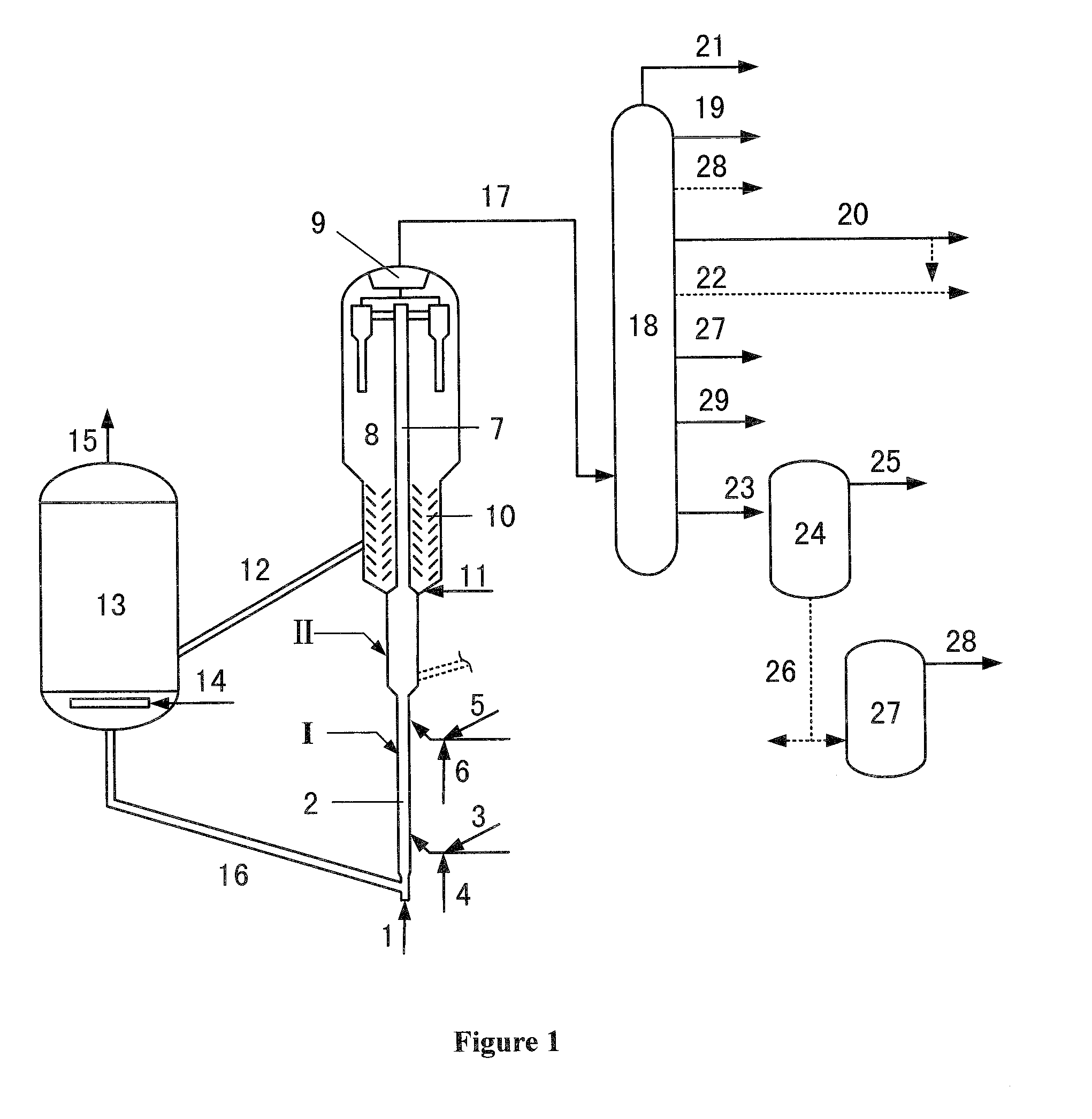Catalytic conversion process for producing more diesel and propylene
a technology of catalytic conversion and propylene, which is applied in the direction of physical/chemical process catalysts, fuels, organic chemistry, etc., can solve the problems of not mentioning any improvement in the properties of diesel, slow development of diesel production technology of high cetane number, and limited petrochemical industry, so as to achieve efficient utilization of petroleum resources
- Summary
- Abstract
- Description
- Claims
- Application Information
AI Technical Summary
Benefits of technology
Problems solved by technology
Method used
Image
Examples
example 1
[0147]Example 1 was conducted according to the procedures as shown in the drawings. The cracking feedstock oil was directly used as the feedstock for catalytic cracking. The catalyst CAT-MP-1 was used for the test conducted on the pilot plant. The cracking feedstock was fed into the middle or upper part of the reaction zone I, and cracked at a reaction temperature of 530° C., a weight hourly space velocity of 35 h−1, a catalytic cracking catalyst / feedstock weight ratio of 4, and a water vapor / feedstock weight ratio of 0.15. In the reaction zone II, the gas oil was cracked at a reaction temperature of 490° C. and a water vapor / feedstock weight ratio of 0.15. The gas oil was separated in the settler from the catalyst with coke, and the product was cut according to the distillation range in the fractioning system to obtain propylene, butylene, gasoline, diesel and fluid catalytic cracking gas oil fractions. The fluid catalytic cracking gas oil was fed into the hydrogenating unit and hy...
example 2
[0151]Example 2 was conducted according to the procedures as shown in the drawings. The feedstock oil, test steps and methods were completely the same as those in Example 1, except that the catalytic cracking catalyst used therein was changed from CAT-MP-1 having a conventional particle size distribution to CAT-MP-2 having a coarse particle size distribution; and the catalyst for producing more diesel used therein was changed from CAT-MD-1 having a conventional particle size distribution to CAT-MD-2 having a coarse particle size distribution. The operating conditions and product distribution are listed in Table 3.
[0152]According to Table 3, it can be seen that the propylene yield is as high as 14.58 wt %; the diesel yield is as high as 19.77 wt %; and the cetane number is 41.
example 3
[0153]Example 3 was conducted according to the procedures as shown in the drawings. The cracking feedstock oil was directly used as the feedstock for catalytic cracking. The catalyst CAT-MP-1 was used for the test conducted on the pilot plant. The cracking feedstock was fed into the middle or upper part of the reaction zone I, and butylene as the re-cracked feedstock was fed into the bottom of the reaction zone I. At the bottom of the reaction zone I, the re-cracked feedstock was cracked at a reaction temperature of 610° C., a weight hourly space velocity of 175 h−1, a catalytic cracking catalyst / feedstock weight ratio of 70, and a water vapor / feedstock weight ratio of 0.20. In the middle and upper parts of the reaction zone I, the catalytic feedstock was cracked at a reaction temperature of 530° C., a weight hourly space velocity of 40 h−1, a catalytic cracking catalyst / feedstock weight ratio of 4, and a water vapor / feedstock weight ratio of 0.15. In the reaction zone II, the gas o...
PUM
| Property | Measurement | Unit |
|---|---|---|
| Temperature | aaaaa | aaaaa |
| Temperature | aaaaa | aaaaa |
| Temperature | aaaaa | aaaaa |
Abstract
Description
Claims
Application Information
 Login to View More
Login to View More - R&D
- Intellectual Property
- Life Sciences
- Materials
- Tech Scout
- Unparalleled Data Quality
- Higher Quality Content
- 60% Fewer Hallucinations
Browse by: Latest US Patents, China's latest patents, Technical Efficacy Thesaurus, Application Domain, Technology Topic, Popular Technical Reports.
© 2025 PatSnap. All rights reserved.Legal|Privacy policy|Modern Slavery Act Transparency Statement|Sitemap|About US| Contact US: help@patsnap.com

